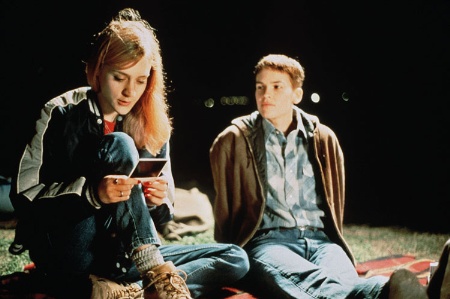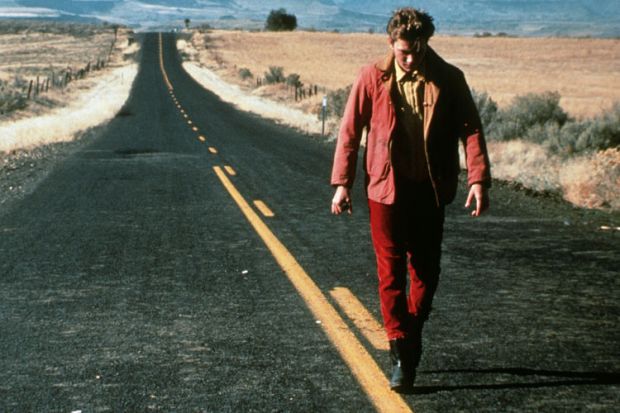Source: Kobal
Landmark movie: River Phoenix starred in My Own Private Idaho – the 1991 film that was part of the wave of work that was christened ‘New Queer Cinema’
New Queer Cinema was characterised by a tenacious refusal to give in to the stigmatisation of gay men, transgender folk and queers
There is a moment in Gus Van Sant’s 1991 film My Own Private Idaho when the main character awakens on a desolate Midwestern American highway.
Mike (River Phoenix) is a gay street hustler who suffers from narcolepsy and experiences periodic lapses in time because of his predilection for dozing off. After abruptly falling asleep, the confused Mike finds himself on a deserted highway staring off into the middle distance, while the road endlessly moves towards the harsh horizon. The wind slowly rustles as acres of scorched yellow grass envelop him.
This scene is one of the most symbolic moments in a moving tale of two adolescent hustlers who struggle to find themselves – both sexually and emotionally – during the height of the HIV/Aids crisis in the US, while society at large shuns these promiscuous and displaced queers.
The highway is one of many metaphors used by director Van Sant to show not only the fine line many queers negotiate – the elusive so-called “straight and narrow” we never seem to be able to successfully trek – but also the in-between status we face as men afforded the privilege of masculinity but vilified because of our desire for the same sex.
My Own Private Idaho was a landmark film when it was released in the early 1990s and joined other standout movies of the time, including Jennie Livingston’s documentary on New York’s underground drag shows, Paris is Burning (1990); Todd Haynes’ feature Poison (1991); Derek Jarman’s version of Christopher Marlowe’s Edward II (1991); and Gregg Araki’s moving road-trip film, The Living End (1992).
This wave of films, famously christened “New Queer Cinema” by the critic B. Ruby Rich, can be seen as a response to the stigma and shame wrought by a culture that continued to pathologise gay men and blame them for the devastating HIV/Aids epidemic. Many embraced the tenets of 1980s queer theory and academic disciplines such as post-structuralism to reconfigure sexuality as a fluid, dynamic and constructed experience. After a decade of neglect by the US government and President Ronald Reagan – who uttered the word “Aids” only years after the crisis began – NQC sought to rectify the absence of authentic gay and queer representations in cinema.
Its energies, I would argue, are still percolating through to us today, 25 years after the initial impact of the movement. But to understand its importance, one must also consider some of the transgressive works that emerged from its urgent desire to challenge representations of homosexuality on screen.
NQC was characterised by a tenacious refusal to give in to the stigmatisation of gay men, transgender folk and queers that had become more pronounced during the previous decade. Instead, through stories of time travel, drag and gender performances, and self-destructive sex-fuelled road trips across the US, directors fought against the abject and hated status of queer identity and defended it as an important and transgressive experience.
This early 1990s cinema was also interested in complicating certain gay figures of the 20th century. Take Swoon (1992), Tom Kalin’s account of the infamous 1920s lovers Richard Loeb and Nathan Leopold Junior, who allegedly killed a 14-year-old boy “for kicks”. Many directors in the gay community would have avoided such a story because it seems to touch on classic Hollywood tropes about gay men as murderous, abject and destructive. Not Kalin, however, who made his film with an achingly mournful black-and-white aesthetic and a deep unapologetic desire to reprioritise the genuine love and passion the pair had for each other, rather than concentrate on the graphic killing.

Yet only years after the NQC movement got under way so powerfully, it seemed to peter out as Hollywood began capitalising on “gay films”. Many have criticised the way that its involvement in the mid- to late 1990s saw representations of gay lives migrate away from destitution and death to suburbia and the urban sprawl. Instead of films rooted in a rejection of the pathologised representations of gay men as abject promiscuous outcasts, we saw them repositioned in more neighbourly and campy mainstream roles.
So, during the late 1990s and early 2000s, we had family-friendly drag queens who saved a small backwards town (To Wong Foo, Thanks For Everything! Julie Newmar, 1995); a monogamous couple in The Birdcage (1996), who cope with their “marriage” problems while their son marries a Republican’s daughter; and the English teacher in In & Out (1997) who is “outed” at the Oscars by a former student. Although some of the energies of these films are invested in white middle America, it is hardly fair to blame NQC for the fact that one of its spin-offs was this series of bad Hollywood comedies that trivialised the plight of gay men and made them the allies of straight communities.
Yet without NQC we would probably never have had the much more striking and powerful films that came after. I am thinking, for example, of Kimberly Peirce’s Boys Don’t Cry (1999), the harrowing true story of a trans man who was beaten and eventually killed by acquaintances; Ang Lee’s Brokeback Mountain (2005); or Van Sant’s biopic Milk (2008). The narratives of these movies are preoccupied with the emotional depth of their characters and making audiences identify with them. They have garnered mainstream critical and commercial success, showing that queer experiences can be real, sometimes difficult, but always worthy of the Hollywood screen.
Other films of the past decade have also drawn on the forcefulness originally released by NQC. These include Hedwig and the Angry Inch (2001), directed by John Cameron Mitchell, who also plays the transgender singer at the centre of the story; Duncan Tucker’s Transamerica (2005), in which a transgender woman sets out on a road trip with her son; and Gregg Akari’s Kaboom (2010), winner of the first Queer Palm at the Cannes Film Festival, which uses science fiction to explore a dizzying range of sexual preferences and practices among a group of college students. These are works that explore the underside of the queer experience, moving beyond gay men to a broader array of under-represented sexualities and identities.
To bring the story even more up to date, it is worth mentioning the Australian film 52 Tuesdays (2013), which explores the struggles between a mother and daughter after the former reveals her plans to gender transition. The pair meet every Tuesday for a year during her transition, which is paralleled with daughter Billie’s own adolescent sexual awakening. Director Sophie Hyde decided to film every Tuesday not only to maintain verisimilitude but also to cultivate a documentary-like style that emphasises the story’s (extra)ordinariness. Since its original release, 52 Tuesdays has played at countless international film festivals and cinemas.
The past two years also saw several projects that instantiated NQC’s original goal of dignifying queer lives with personalised and intimate emotional stories – and, of course, screen time. Abdellatif Kechiche’s Blue is the Warmest Colour (originally La Vie d’Adèle, 2013), based on Julie Maroh’s 2010 French graphic novel, offers a vivid account of a lesbian awakening and love affair. Matthew Warchus’ Pride (2014) considers the lesbian and gay activists who supported the 1984 miners’ strike. (Just how far we still have to go, however, is suggested by the DVD release of this film, which was marred by the appearance of a bad photoshop job on the front cover – out have gone the gay pride banners and in instead has come Big Ben. This alteration suggests that its mainstream reception requires Pride to be seen as a political protest film, rather than the indignant condemnation of homophobia it really is.)
No doubt 2015 will bring us some films as moving and as inspiring as these, while we take stock and remember the anger and contempt that ignited 25 years ago. NQC was a pioneering and transgressive challenge that used film to show that queer lives are meaningful, unique and indeed necessary for the moving image.
Register to continue
Why register?
- Registration is free and only takes a moment
- Once registered, you can read 3 articles a month
- Sign up for our newsletter
Subscribe
Or subscribe for unlimited access to:
- Unlimited access to news, views, insights & reviews
- Digital editions
- Digital access to THE’s university and college rankings analysis
Already registered or a current subscriber? Login

